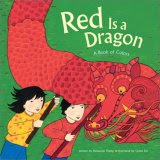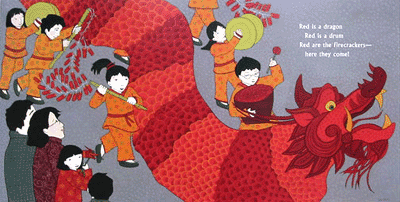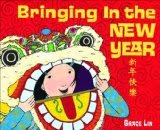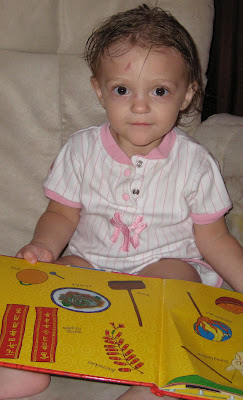 Over the past week or so, my daughter has gravitated toward the two Grace Lin books we have in our house.
Over the past week or so, my daughter has gravitated toward the two Grace Lin books we have in our house.
First, Chronicle Books sent us the paperback version of Red is a Dragon: A Book of Colors, written by Roseanne Thong and illustrated by Grace Lin. It's a concept book written in rhyme that features gorgeous spreads of Chinese characters in both Asian-themed and familiar settings with objects in the color featured on the spread.
For example, here's the opening of the book:

The text is "Red is a dragon/ Red is a drum/ Red are the firecrackers--here they come!" The book continues with many more colors: yellow raincoats, flowers, and a taxi; green toads, bottle gourds, and jade; a blue pool, dragonfly, and pair of sneakers; pink peonies, white dumplings, and more. A glossary in the back explains more about some of the items in the book that some kids may not be familiar with, such as lychee fruit, chopsticks, silk fans, and more. This is a wonderful way to not only teach colors but to also introduce children to another culture.

And speaking of teaching kids about different cultures, take a look at Lin's book,
Bringing in the New Year (Knopf Books for Young Readers, 2008). Both written and illustrated by Lin, this book follows a Chinese family as they prepare for and then celebrate the Lunar New Year.
The entire family participates in the preparations: "Ba-Ba hangs the spring happiness poems. Ma-Ma makes the get-rich dumplings. Mei-Mei gets a fresh haircut."
The preparations lead up to an exciting celebration with firecrackers, the arrival of "lions" to scare away last year's bad luck, and an exciting pull-out three-page spread of the arrival of the dragon. Here's just one page of this impressive and vibrantly-colored spread:
At the end of the book is a two-page summary of the Lunar New Year, which includes information about the customs and traditions of this special holiday. And if anyone doubts the importance of having fun, colorful end papers, check out my little one who is fascinated with the end papers in this book. This one was taken earlier this week during our post-bath time reading session.
Yes, she loves Grace Lin, and we're definitely going to add to our collection. Check out
Grace Lin's Website for more information about all of her books.

Hi Everyone!
I'm thrilled to be here, sharing some thoughts with you. I'm just back from Boston, where I was honored to received an award for my latest book, Where in the Wild? Camouflaged Creatures Concealed... and Revealed, which I co-authored with my wife, Yael Schy. (Our book was awarded the 2008 SB&F Prize for Excellence in Science Books in the category "Children's Science Picture Book." The award is sponsored by Subaru and the American Association for the Advancement of Science and it was shared between the two authors and photographer Dwight Kuhn.) I was planning to write about the award ceremony and the four books that received the prize in different categories (see www.sbfonline/prizes) but I have decided to save that for another day,
 except to give you a glimpse of our book's cover and to share one detail about the ceremony. The sponsors of the SB&F Prize arranged to have several local children present the awards to the winning authors. The kids told the audience (and the authors) what they liked about the books. Some of them spoke with passion about questions the books had raised in their minds. To these readers, a book that raises interesting questions is a good book indeed. Then the young book reviewers shook our hands while handing us our award plaques.
except to give you a glimpse of our book's cover and to share one detail about the ceremony. The sponsors of the SB&F Prize arranged to have several local children present the awards to the winning authors. The kids told the audience (and the authors) what they liked about the books. Some of them spoke with passion about questions the books had raised in their minds. To these readers, a book that raises interesting questions is a good book indeed. Then the young book reviewers shook our hands while handing us our award plaques.
The opinions and questions of children often fascinate and delight me. I get a lot of great letters from children and I would be hard-pressed to pick a favorite, but one letter that stands out in my mind came from a nine-year old girl who wondered about the accuracy of various statements in my first book. I'm going to remove her name and address to protect her privacy, but we can call her by her first name, Lisa. Here is what she wrote. I apologize that the letters are small and a little hard to read. Lisa's message is summarized in the last two sentences:
 In my presentations at schools, I often tell children, "Wondering is wonderful." I find it wonderful that Lisa is wondering about the statements in my book and whether or not they are true. These musings give her "mixed up feelings," which may sound uncomfortable, but she quickly goes on to reassure us that she finds these feelings magical. Her letter ends with a sentence I find truly memorable. To Lisa, the magic in books is wondering whether the "facts" are true or not!
In my presentations at schools, I often tell children, "Wondering is wonderful." I find it wonderful that Lisa is wondering about the statements in my book and whether or not they are true. These musings give her "mixed up feelings," which may sound uncomfortable, but she quickly goes on to reassure us that she finds these feelings magical. Her letter ends with a sentence I find truly memorable. To Lisa, the magic in books is wondering whether the "facts" are true or not! 
I wish readers of my books -- or all books -- would wonder about them the way Lisa does. Active minds read critically, questioning what they read as they blend their own experiences, knowledge and observations with the author's raw ingredients. They create a nourishing stew that is more than a bowl of information.
I have been lucky enough to see see many examples of readers extending or challenging statements in my books. The 2rd and 3rd graders of one class doubted that the average height of elementary school students was truly 4'8", as I reported in the backmatter of How Much Is a Million? I used that figure to estimate the height of a million children standing on one another's shoulders. To find out if I was right, this class set about measuring every child in their elementary school. They determined the median, the mode and the mean, and they graphed their data. Finally, they declared that the average height was only 4'4".
But they didn't quit there. They proposed several possible explanations for the discrepancy between what I had written and what they had found. For example, their school has grades from K-5. Maybe my school went up to 6th or 8th grade. If so, that could explain the difference between their answer and mine. Or, they speculated, their school might be shorter than normal... or perhaps mine was taller than normal. Or maybe I just measured a single child with a height of 4'8" and I said, "He's normal!" In a scientific paper, this section of their report would have been the "discussion" section.
 I'll give just one other example of children wondering about what they have read.
I'll give just one other example of children wondering about what they have read.
In If You Made a Million, I wrote that a million dollars would be equal to "a whale's weight in quarters." A group of schoolkids wondered about that. They looked up the weight of a blue whale (60 tons) and calculated that it is the same as the weight of 10 million quarters, or 2.5 million dollars -- not one million dollars as the book said. When they wrote to me about it, I pointed out that the book did not specify a particular species of whale. And in the backmatter, where I explained the math, I showed that the weight of a million dollars in quarters is about 50,000 pounds, which is "the approximate weight of many kinds of whales, including the sperm whale." Then, as if anticipating their objection, I added that blue whales can be much heavier than that. I thought I had covered my bases and I said so (nicely) in a letter to my challengers, but they were not convinced. Here is a copy of the page that they sent back to me, bearing their comment upon the situation:
Don't you love it? I sure do. I told them they would have to take it up with the illustrator, Steven Kellogg. And I even provided his address!
To me, the point isn't who is right and who is wrong. The point is that they wondered about something they had read in a book ... and they pursued their wonders through research and mathematics. It's magical. As nine year-old Lisa said, "The magic of books is not knowing whether the facts are true or not."
 Over the past week or so, my daughter has gravitated toward the two Grace Lin books we have in our house.
Over the past week or so, my daughter has gravitated toward the two Grace Lin books we have in our house. And speaking of teaching kids about different cultures, take a look at Lin's book, Bringing in the New Year (Knopf Books for Young Readers, 2008). Both written and illustrated by Lin, this book follows a Chinese family as they prepare for and then celebrate the Lunar New Year.
And speaking of teaching kids about different cultures, take a look at Lin's book, Bringing in the New Year (Knopf Books for Young Readers, 2008). Both written and illustrated by Lin, this book follows a Chinese family as they prepare for and then celebrate the Lunar New Year.








Grace Lin is one of our favorites too! My oldest always loved The Seven Chinese Sisters, illustrated by Lin. You should check that one out!
Stephanie...
I'll definitely check out The Seven Chinese Sisters. It definitely seems right up our ally. Thanks for stopping by!